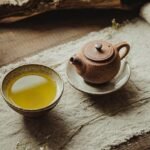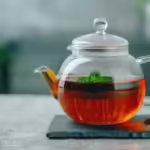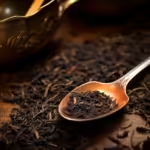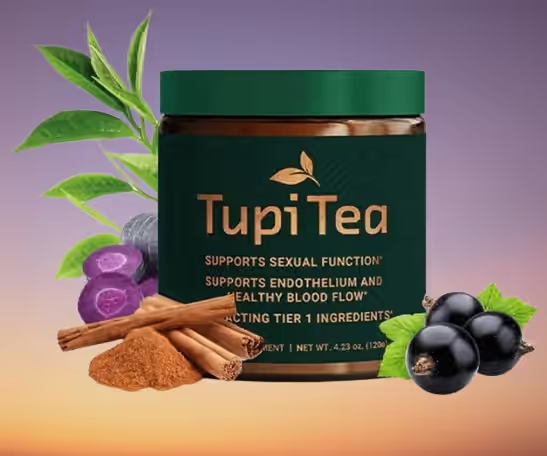Table of Contents
Introduction: A Complete Content Overview
Pu-erh tea is an ancient, revered tea from China that has gained global popularity due to its unique flavor and potential health benefits. As with any tea, one common question arises: Does pu erh tea have caffeine? Understanding its caffeine content is crucial for tea enthusiasts who want to enjoy the beverage without overindulging in caffein. This post dives deep into pu-erh tea, how it’s made, its caffeine levels, and the factors that influence them. If you’re looking to view the full benefits, keep reading.
1. What is Pu-Erh Tea?
Pu-erh tea (also spelled “puerh” or “pu’er”) is a fermented tea originating from Yunnan province in China. Unlike other teas, which are consumed soon after production, pu-erh undergoes an aging process that can last anywhere from months to decades. This fermentation gives pu-erh its distinctive earthy flavor and aroma, making it a favorite among tea connoisseurs. Many people consider pu-erh to be top of the line in terms of flavor complexity and health benefits.
Pu-erh tea (also spelled “puerh” or “pu’er”) is a fermented tea originating from Yunnan province in China. Unlike other teas, which are consumed soon after production, pu-erh undergoes an aging process that can last anywhere from months to decades. This fermentation gives pu-erh its distinctive earthy flavor and aroma, making it a favorite among tea connoisseurs. Many people consider puer to be top of the line in terms of flavor complexity and health benefits.
There are two main types of pu-erh tea: raw (sheng) and ripe (shou). Each type differs in production method, flavor profile, and caffeine content. We’ll explore these differences further down, but first, let’s look at how pu-erh tea is made.
2. How Pu-Erh Tea is Made: The Art of Crafting Mansa Tea and Cha
The process of making pu-erh tea starts similarly to green tea. Tea leaves are harvested, withered, and then pan-fried to stop oxidation. From here, the path to becoming pu-erh tea diverges, with distinct methods for creating different varieties like Mansa Tea and Cha:
- Raw Pu Erh (Sheng Pu Erh): After the initial processing, the tea is shaped into cakes or bricks and left to naturally ferment and age. This aging process can take several years, during which the tea’s flavor deepens, becoming more complex and mellow. The result is a tea similar to traditional Mansa Tea, known for its vibrant, evolving flavor profile.
- Ripe Pu Erh (Shou Pu Erh): To meet demand for aged tea without waiting years, ripe pu erh is created by speeding up the fermentation process. Tea producers use a technique called “wet piling” (wo dui) to mimic the aging process of raw pu erh in a much shorter time frame. The result is a smoother, less astringent tea, often likened to Cha, a style known for its mellow and earthy qualities.
Both types of pu-erh tea have their loyal followers, but one question remains: does pu erh tea have caffeine?
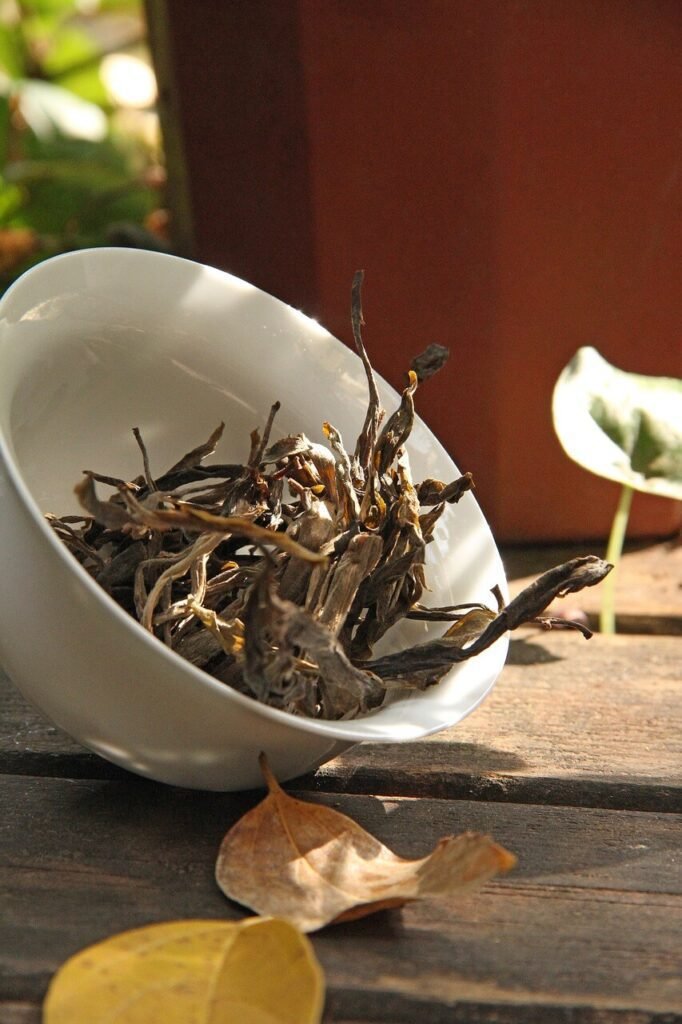
3. Does Pu-Erh Tea Have Caffeine? A Comparison of Caffeine in Teas
Yes, pu-erh tea contains caffeine, but the amount depends on several factors. Caffeine is naturally present in all types of tea made from the Camellia sinensis plant, including black, green, white, oolong, and pu-erh teas. Some varieties of pu-erh, especially raw pu-erh, can be considered high caffeine teas.
On average, a cup of pu-erh tea contains between 30 to 70 mg of caffeine, placing it in the mid-range compared to other teas. For context:
- Black tea: 40 to 70 mg per cup.
- Green tea: 20 to 45 mg per cup.
- White tea: 15 to 30 mg per cup.
- Oolong tea: 30 to 50 mg per cup.
So while pu-erh tea does contain caffeine, it is generally comparable to green or oolong tea in terms of caffeine levels.
4. Raw Pu Erh vs. Ripe Pu Erh: How Caffeine Differs
The two types of pu erh—raw and ripe—differ in their caffeine content due to the variations in processing. Raw pu erh tends to have higher caffeine levels, especially when young, because the fermentation process in ripe pu erh reduces some of the caffeine content. Here’s how they compare:
- Raw Pu Erh: Because it is less fermented, raw pu erh generally retains more caffeine, especially in its early years of aging. As raw pu erh ages, the caffeine content gradually diminishes.
- Ripe Pu Erh: Due to the accelerated fermentation process, ripe pu erh tends to have a lower caffeine level compared to raw pu erh. This makes it a good option for those who want the benefits of pu erh tea with a more moderate caffeine intake.
5. Factors Affecting Caffeine Levels in Pu-Erh Tea
While raw and ripe pu-erh have their inherent caffeine differences, other factors influence the final caffeine content in your cup:
Brewing Time
Longer brewing times generally extract more caffeine from the tea leaves. If you’re looking for a stronger kick of caffeine, brewing your pu-erh tea for a longer period will increase its potency. Conversely, a shorter brewing time will result in a milder tea with less caffeine.
Tea Leaf Type : Key Factor in Caffeine Content
Pu-erh tea leaves come in a variety of grades, from whole leaves to smaller broken leaves or dust. Higher-grade whole leaves tend to have less caffeine than broken leaves or tea dust, which can release caffeine more quickly when steeped.
Fermentation and Aging
The fermentation process of pu-erh tea can break down some of the caffeine content over time. As a result, older pu-erh teas generally have lower caffeine levels than their younger counterparts, particularly in raw pu-erh.
6. Pu-Erh Tea Benefits and Its Caffeine Effects
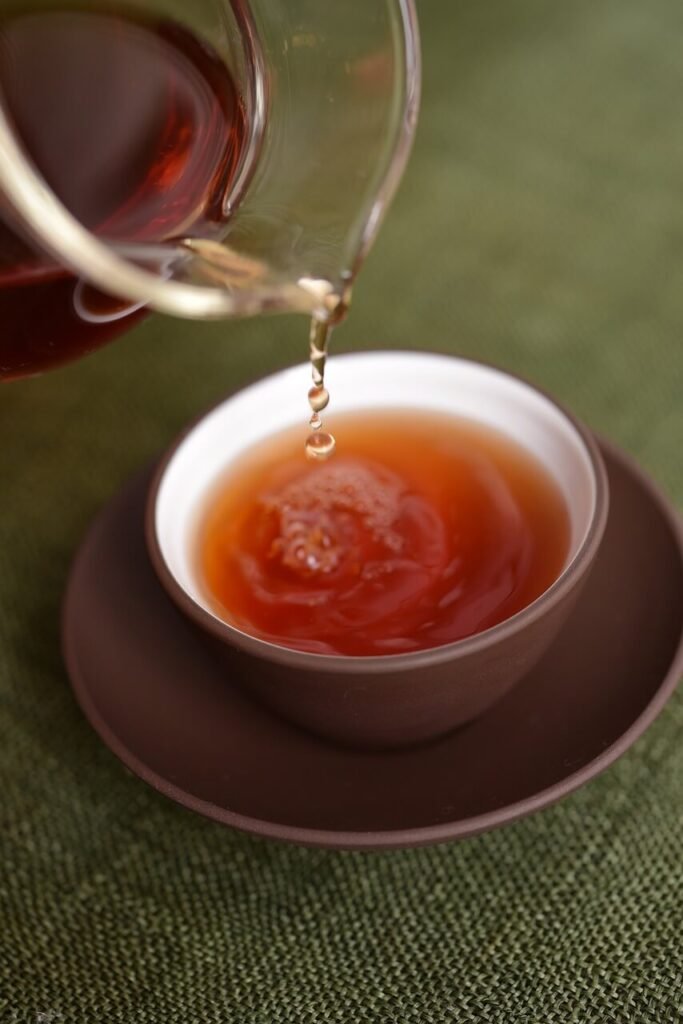
Beyond its caffeine content, pu-erh tea offers several health benefits. The fermentation process gives pu-erh unique properties that differentiate it from other teas.
Improved Digestion
Pu-erh tea is often consumed after meals in China due to its ability to aid digestion. The fermented tea contains probiotics that can help improve gut health and support digestion.
Weight Loss
Research suggests that pu-erh tea may promote weight loss by increasing metabolism and fat oxidation. Caffeine, in particular, plays a role in this, as it is known to boost metabolism and help with fat burning. However, the catechins and polyphenols in pu-erh are also believed to contribute to these effects.
Lower Cholesterol
Some studies indicate that pu-erh tea may help lower LDL (bad) cholesterol levels and increase HDL (good) cholesterol, contributing to better heart health.
Enhanced Alertness and Focus
Like other caffeinated beverages, pu-erh tea can enhance mental alertness and focus. However, because it contains moderate amounts of caffeine, it provides a more balanced boost compared to coffee, which can cause jitteriness.
7. Myths and Misconceptions About Pu-Erh Tea and Caffeine
There are several misconceptions about pu-erh tea and its caffeine content. Let’s debunk some of the most common myths:
“Pu-Erh Tea is Caffeine-Free”
This is a myth. While pu-erh tea contains lower levels of caffeine compared to coffee, it is by no means caffeine-free. As mentioned, it generally contains between 30 and 70 mg of caffeine per cup.
“Aged Pu-Erh Tea Has No Caffeine”
While it’s true that older pu-erh tea may have less caffeine than younger tea, it does not become completely caffeine-free over time. Aging reduces the caffeine content, but traces of it will always remain.
“Ripe Pu Erh Has More Caffeine Than Raw Pu Erh”
As discussed, ripe pu erh generally contains less caffeine due to the wet piling fermentation process, which reduces caffeine content over time.
8. How to Brew the Perfect Cup of Pu-Erh Tea for Maximum Flavor and Energy
Brewing the perfect cup of Pu-Erh tea is an art that combines tradition with modern techniques to unlock its full potential in flavor and energy. Whether you’re a seasoned tea enthusiast or just beginning your journey, understanding the right brewing methods can elevate your experience.
Brewing Methods for Pu-Erh Tea
Start by choosing high-quality Pu-Erh leaves, as the foundation of any great brew lies in the quality of the tea itself. When it comes to brewing techniques, you have options: traditional versus modern.
Traditional vs. Modern Brewing Techniques for Energy Boost
Traditional methods often involve multiple short infusions using a gaiwan or Yixing teapot, which allows you to savor each unique infusion’s evolving profile. This method not only enriches flavor but also provides a gradual energy boost throughout your session.
Benefits of traditional methods:
- Allows for multiple infusions.
- Gradual energy release with each steep.
- Deepens the flavor profile with each infusion.
On the other hand, modern techniques may include using Western-style teapots or even specialized tea makers that simplify the process while still delivering robust taste and energizing effects. These approaches are perfect for those seeking convenience without compromising quality.
Steeping Time for Optimal Taste and Caffeine Extraction
For optimal taste and caffeine extraction, pay close attention to steeping time. A general rule is to steep Pu-Erh tea for:
- 3 minutes for a lighter flavor and moderate caffeine.
- 4 minutes for a balanced taste with increased energy.
- 5 minutes for a strong flavor and higher caffeine content.
Shorter steeping times will yield a lighter flavor with moderate energy, while longer durations enhance both taste intensity and caffeine content.
“Mastering the steeping time is key to unlocking the full potential of your Pu-Erh tea.”
By mastering these brewing methods for Pu-Erh tea and experimenting with steeping times, you’ll discover how this ancient beverage can become a powerful ally in both flavor exploration and sustained energy throughout your day.
Conclusion: Is Pu-Erh Tea Right for You?
To answer the question “Does pu erh tea have caffeine?“—yes, it does, but the amount varies based on factors like tea type, brewing time, and aging. For those looking for a balanced caffeine option, pu-erh tea offers an enjoyable alternative with Pu-Erh Tea benefits that can enhance overall health. So, if you’re considering adding this unique tea to your routine, it could be a delightful choice.
Whether you’re drawn to its earthy flavor, digestive benefits, or potential weight-loss properties, pu-erh tea offers a balanced, enjoyable way to consume caffeine without overdoing it. If you’re sensitive to caffeine or prefer a milder boost, consider opting for ripe pu-erh or reducing your brewing time.
Pu erh tea has stood the test of time, and understanding its caffein content can help you enjoy this ancient brew responsibly and to its fullest potential.



